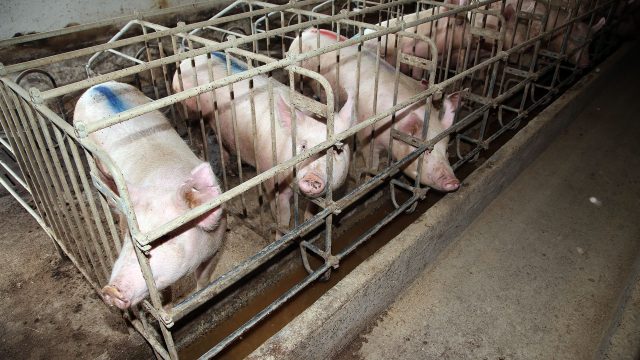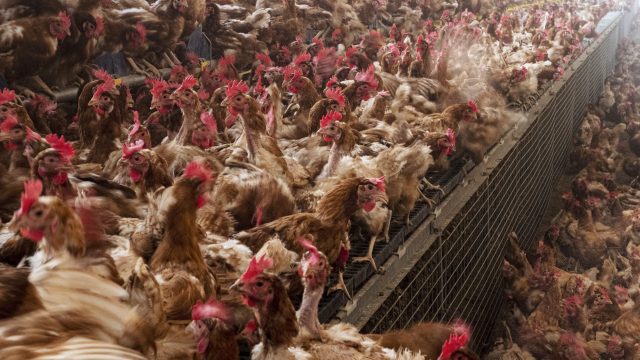
Industrial Animal Agriculture: Exploiting Workers and Animals
The animal agriculture industry — which is primarily comprised of enormous, multinational corporations — profits1 from exploiting animals and humans alike. Exploited humans include industry workers, who labor on factory farms and in slaughterhouses and meatpacking plants. These workers earn poverty wages2 to perform dangerous and traumatic jobs.
Factory Farm Workers
On factory farms, farmers — typically contract growers — bear all of the risk and hazards of raising vast numbers of animals in intensive confinement, while the vertically integrated corporations — Tyson, JBS, Smithfield, and the like — own the animals, control the manner of raising them, and reap all the financial reward. The result is a race to the bottom that pits farmers against each other in pursuit of ever greater speed and efficiency, with animals and workers the unfortunate casualties.
Workers on factory farms — some of whom are imprisoned persons or are members of otherwise vulnerable populations3 — have even less power than their contract grower employers, and labor in dangerous, dirty environments. Factory farms are literal cesspools — confining thousands of animals together in close quarters among and above their own waste, which may be teeming with insects and rodents.4 Animals are dosed with antibiotics, hormones, and other drugs, like beta-agonists ractopamine and zilpaterol, to keep them gaining weight and prevent them from succumbing to illness in their disease-ridden quarters.
In such environments, workers are exposed to serious health threats including viruses like bird flu and swine flu, as well as drug resistant bacteria. Bacteria such as salmonella, E. coli, and staph, can jump from confined animals to workers, causing Methicillin-resistant Staphylococcus aureus (MRSA) and other difficult-to-treat infections.5 Exposure to beta-agonists like ractopamine has been linked to adverse reactions in factory farm workers and producers, with the Food and Drug Administration (FDA) receiving complaints of nausea, dizziness, headaches, fever, nose bleeds, respiratory issues and chest pain, allergic reactions, cardiac issues such as irregular heartbeat and rapid heartbeat, and other serious medical conditions, from workers directly exposed to animals fed beta-agonists (and from consumers who eat the meat of beta-agonist-fed animals).6
Inside the vast, windowless sheds on factory farms, workers breathe air permeated with noxious gases including ammonia and hydrogen sulfide, and with dust and dander. Factory farms are a major source of particulate matter — tiny particles made up of dried manure, bedding materials, animal dander, and chicken and turkey feathers — that can cause or contribute to several respiratory diseases.7
Inside these environments, workers must perform dangerous jobs — moving stressed, aggressive pigs among tight, confined spaces, for example, or gathering and catching panicked chickens as quickly as possible. Teams of chicken catchers, typically employed by subcontractors of the chicken companies, crowd together in vans at night to go to factory farms.8 Workers grab the birds up by hand, by the thousands, and load them into cages for transport to slaughter, making about $2 per worker for every thousand small chickens the crew catches. Workers’ hands become injured and disfigured from the dangerous, repetitive motions.9 Factory farm workers may also have to subject struggling animals to “processing” —performing amputations, such as tail docking, without anesthesia — or kill them by crude means, such as manual blunt force trauma (slamming piglets’ heads on the floor or wall).
On top of this, when emergencies, like the COVID-19 pandemic, occur, slaughterhouses may slow down and halt processing, and factory farm workers may be forced to quickly kill and dispose of thousands or even hundreds of thousands of animals in environments that were never meant for such mass slaughter. Killing animals by foam, gassing, or even ventilation shutdown — turning off air vents and suffocating or cooking the animals to death inside the barns — workers must then dispose of the thousands of bodies, including through on-site incineration or mass burial.
Having to engage in these large-scale cruelties day after day, in dangerous and dirty environments, exacts a steep physical and psychological toll on factory farm workers.10
Slaughterhouse and Meatpacking Plant Workers
There are more than 330,000 workers in slaughterhouses and meatpacking plants across the country.11 They have long been rife with “systematic human rights violations” and exploitation.12 Working in a slaughterhouse is one of the most dangerous jobs in the United States.13 Workers are more than three times likely than workers in other industries to become injured on the clock, and there are an average of two amputations each week.14 An average of eight workers die each year.15 And even if a worker is lucky enough to avoid catastrophic injury or death, they will nonetheless be subject to the “cumulative trauma of repeating the same, forceful motions, tens of thousands of times each day,” which can cause chronic pain and severe and disabling injuries over time.16
Further exacerbating the dangerous and exploitative conditions in slaughterhouses and meatpacking plants is the fact that most workers are marginalized and minoritized humans. Like on factory farms, some workers are imprisoned persons.17 Virtually all workers are low-wealth, and most are Black, Indigenous, Latino, and other people of color.18 Many workers are refugees,19 while up to one third are immigrants and one quarter are undocumented.20 Such vulnerable workers are often too afraid — of retaliation and/or deportation — to report injuries, illness, dangerous working conditions, harassment, other labor violations, or environmental or animal welfare violations.21 The animal agriculture industry exploits these vulnerabilities to maximize profits at the expense of workers.
References
- For example, Tyson Foods, which is the largest processor of chickens in the United States, raked in more than $3 billion in profits in 2018 alone. “When We’re Dead and Buried, Our Bones Will Keep Hurting,” Workers’ Rights Under Threat in US Meat and Poultry Plants, Human Rights Watch (Sep. 4, 2019). Smithfield, which is owned by WH Group, the world’s largest producer of pig meat, reported more than $15 billion in revenue in 2018. Profit Over People: The Meat Industry’s Exploitation of Vulnerable Workers, Sentient Media (Apr. 30, 2020).
- Workers earn, on average, less than $14 per hour. Occupational Employment and Wages, May 2018, 51-3023 Slaughterers and Meat Packers, U.S. Dep’t of Labor. (last visited July 10, 2020)
- See, e.g., Dave Biscobing, Inmates catch COVID-19 at Hickman’s egg farm, ABC15 (June 30, 2020).
- Aysha Akhtar, I studied factory farms for years. Visiting one was far worse than I imagined, Salon (Apr. 20, 2019).
- M. Carrel et al., Residential Proximity to Large Numbers of Swine in Feeding Operations Is Associated with Increased Risk of Methicillin-Resistant Staphylococcus aureus Colonization at Time of Hospital Admission in Rural Iowa Veterans, 35 Infection Control & Hosp. Epidemiology 190 (2014) (jump to vulnerable Iowa residents); J.A. Casey et al., High-Density Livestock Operations, Crop Field Application of Manure, and Risk of Community-Associated Methicillin-Resistant Staphylococcus aureus Infection in Pennsylvania, 21 JAMA Intern Med. 1980 (Sept. 2013) (elevated rates of infection in study of nearly 450,000 Pennsylvania residents).
- Sept. 24, 2013 Veterinary Adverse Drug Reaction, Lack of Effectiveness, Product Defect Report for Zilmax (describing worker experiencing “chemical pneumonia” and consequent permanent lung and heart damage because of inhalation of zilpaterol added to feed bin); Excerpts of Adverse Drug Experience Reports regarding human exposure to ractopamine (including, inter alia, nosebleeds, headaches, and fevers after inhaling the drug); Ctr. Veterinary Medicine, FDA, CVM ADE Comprehensive Clinical Detail Listing (1987-2011) (compiling statistics of adverse drug reactions, including in humans).
- Carrie Hribar, Nat’l Assoc. of Local Bds. of Health, Understanding Concentrated Animal Feeding Operations and Their Impacts on Communities 10 (2010), Centers for Disease Control and Prevention.
- You’re an essential worker. Do you get essential protections? Marketplace (May 13, 2020).
- Id.
- Tani Khara, Animals suffer for meat production – and abattoir workers do too, The Conversation (Feb. 4, 2020).
- Human Rights Watch, supra note 1.
- Blood, Sweat, and Fear: Workers’ Rights in U.S. Meat and Poultry Plants, Human Rights Watch (Jan. 24, 2005).
- “Moving machine parts can cause traumatic injuries by crushing, amputating, burning, and slicing,” and workers are forced to labor shoulder to shoulder while wielding knives, hooks, scissors, saws, and other tools that can “cut, stab, and infect.” Human Rights Watch, supra note 1.
- Andrew Wasley et al., Two amputations a week: the cost of working in a US meat plant, The Guardian (July 5, 2018).
- Human Rights Watch, supra note 1.
- Id.
- See, e.g., Will Tucker, Should prisons be in business with one of the most dangerous industries in America? Southern Poverty L. Ctr. (July 26, 2018), (“[T]hough they’re among the nation’s most dangerous workplaces, poultry plants . . . continue to benefit from what is perhaps the most vulnerable workforce in the country – prisoners.”).
- Human Rights Watch, supra note 1.
- Refugee Workers on the Frontlines and as Essential Workers, New Am. Econ. Res. Fund (June 18, 2020).
- Human Rights Watch, supra note 1.
- Id.
Report Animal Agriculture
Report animal abuse, worker safety concerns, depopulation, or illegal disposal confidentially.
Related
-
Whistleblowers Sought as COVID-19 Ravages Industrial Animal Agriculture Industry
A series of billboards, in English and Spanish, are launching near slaughterhouses across the country — offering an online tip portal where industrial animal agriculture workers can report any concerns. Joaquin Phoenix partnered with the Animal Legal Defense Fund in offering and promoting ReportAnimalAg.com to allow individuals to remain anonymous.July 6, 2020 Press Release -
As COVID Pummels Slaughterhouse Workers, Meat Companies Won’t Slow Down
The USDA and its meat corporation clientele are resisting calls to halt or even delay slaughterhouses’ adoption of the controversial high-speed, deregulated pig and poultry slaughter inspection systems.April 14, 2020 News



